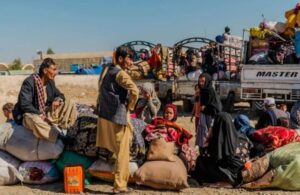KABUL (SW) – Kabul, with all its beauty, also harbors deep sorrows. In its traffic-clogged streets, children wander aimlessly, carrying the heavy burdens of life on their frail shoulders. These are the children who, due to poverty, have been torn from the simple world of childhood and forced to become breadwinners for their families.
Ali is one of these children—a brave and energetic boy, qualities required of any child working the streets of Kabul.
Ali, who has two sisters and three brothers, says that his father’s inability to meet all the family’s needs has forced him to spend part of his life, just like the burning incense in his pot, working on the streets of Kabul’s Pol-e-Surkh area.
“My father is a tire repair technician. God is merciful. I make 50 to 100 afghanis a day; but it’s not a good job.”
The stories of child laborers are increasingly tragic and bitter. Ali’s friend, Baryali, also burns incense on the street to earn a few afghanis.
Baryali, who says he is 10 years old, lost his father years ago and now struggles to provide for his family. “I have four brothers. The problems at home are many. I work for 60 or 70 afghanis daily. Life goes on like this.”
On another corner of Kabul city, on a sidewalk in Dasht-e-Barchi area, a 9- or 10-year-old boy, like many others, is trying to carry the weight of his family’s life at the cost of losing his own childhood.
He introduces himself as Ali Hussain, and with a scale in front of him, he weighs others, hoping to earn a few afghanis and ease the weight on his own shoulders. “My father is sick and paralyzed, so he can’t work. I have three siblings.”
In another alley in Kabul’s District 6, 13-year-old Ahmad, while announcing the arrival of ice cream with the loudspeaker of his four-wheeled cart, moves further away from his childhood and into the world of adults. “I sell ice cream. My father is sick, and I have to work. We are in debt,” he said.
These stories represent just a glimpse into the harsh realities of child labor in the streets. Poverty, which has placed many citizens in difficult situations, has also robbed these children of their joy.
Regarding the steps taken to address child labor in Afghanistan, Kate Elizabeth Pond, communications manager for the United Nations Children’s Fund (UNICEF) in Afghanistan, says: “UNICEF and its partners are working to find solutions that would reintegrate these children into the education system and provide them with opportunities for a better future.”
Although exact statistics on child labor in Afghanistan have not been provided, UNICEF has registered 15,700 working children in the streets of the country.
Reports suggest that many of these children, driven by years of war and economic crisis, have been forced into the streets to find a little money to survive.
While children working in the streets of Afghanistan, especially those who earn their livelihood there, are far from living well, Samiullah Ebrahimi, spokesperson for the Ministry of Labor and Social Affairs under the Islamic Emirate, explains the government’s efforts to support street children: “The government has established orphanages and support centers to help street children. However, we still need humanitarian assistance and the support of the international community to improve the situation for these children.”






